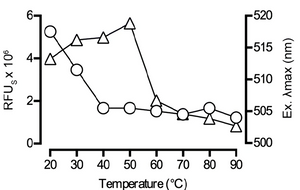
As starch is a thermo-sensitive material that undergoes drastic morphological changes when heated, it is even possible to monitor starch reorganization during heat-induced swelling. When freshly extracted potato starch granules marked with Carbotrace 680 are heated from 20 °C to 90 °C and imaged with a confocal microscope, it becomes obvious that no change in granule size and morphology occurs until the granules are heated to 60 °C. At temperatures higher than 60 °C swelling is observed which can be identified by growing starch granules, but also by a visible change in the fluorescence color and intensity produced by Carbotrace 680 (See image).
Fluorescence intensity (RFU) and color (determined by the wavelength at the excitation maximum, λ - Exmax) can be easily quantified using a fluorescence plate reader. This method greatly improves and simplifies the detection of heat-induced morphological changes in starch, since minor rearrangements in starch packing and swelling can be identified. While the RFU gives an indication on the onset of swelling, λ - Exmax identifies early, heat-induced starch rearrangement, long before morphological changes become visible.
Image: Freshly extracted potato starch granules marked with Carbotrace 680 are heated from 20 °C to 90 °C and the fluorescence intensity (RFU, circels) and color (λ - Exmax, triangles) are quantified using a fluorescence plate reader. The image is reproduced from Choong et al. 2019 (CC BY 4.0).
Detailed analysis of starch structure and morphology enabled by Carbotrace 680 can facilitate quality management of starch raw materials for use in food and pharmaceutical industries where starch reaction with water plays a pivotal role for texture and taste as well as for packing and release kinetics of pharmaceuticals.
